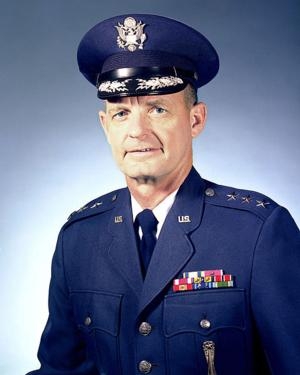Led The Space Center From 1987-1991
Forrest S. McCartney (pictured), former director of NASA's John F. Kennedy Space Center, died July 17, 2012, with his family in attendance. He was 81 years old. McCartney, of Indialantic, FL, was Kennedy's director from Sept. 1, 1987, until Dec. 21, 1991. "It is with great sadness that I learned of the passing of former Kennedy Space Center Director Forrest McCartney," said Kennedy Director Robert Cabana. "Forrest was one of the finest gentlemen I have ever known, and no one cared more for the KSC team than Gen. McCartney. He was always out in the processing areas talking with the troops and getting the pulse of KSC. He was a man with the highest integrity who always did the right thing. He will most certainly be missed."

"On behalf of the entire NASA family, I wish to express our condolences on the passing of Retired United States Air Force Lt. General and former Kennedy Space Center Director Forrest S. McCartney," said NASA Administrator Charles Bolden in a statement. "We are grateful for his many contributions and we honor his legacy by rededicating ourselves to the values of exploration, education and inspiration that were the hallmarks of his life. Our thoughts and prayers are with his wife Ruth and the McCartney family."
McCartney served as director of Kennedy under detail from the U. S. Air Force beginning Oct. 1, 1986. He came to NASA from the position of commander, Air Force Space Division and concluded a distinguished 35-year military career on Aug. 31, 1987, with a retirement ceremony at the office of the Secretary of the Air Force in the Pentagon.
Born March 23, 1931, in Ft. Payne, AL, McCartney graduated from Gulfcoast Military Academy in 1949. He received a Bachelor of Science in electrical engineering from the Alabama Polytechnic Institute in 1952. His first military assignment was with the Air Force Logistics Command at Robins Air Force Base, GA.
McCartney earned a master's degree in nuclear engineering from the Air Force Institute of Technology, Wright-Patterson Air Force Base, Ohio, in 1955. Upon graduation he served as project officer for various special weapons programs, and for nuclear weapons safety systems studies at the Special Weapons Center, Kirtland Air Force Base, NM. He also graduated from the Armed Forces Staff College, Norfolk, VA, in 1967.
McCartney's first Air Force assignments included duty as a satellite controller at the Satellite Control Facility, Sunnyvale, CA, in 1959 during early space operations; an assignment at the Office of Space Activities, Air Force Systems Command Headquarters, Andrews Air Force Base, MD, from 1961 to 1966; and service as a project officer in the Titan II program and various Air Force communication satellite programs. He was assigned to the Directorate of Space at U.S. Air Force Headquarters, Washington, D.C., in 1967, as the program element monitor for satellite communications programs and other selected space-related efforts.
Gen. McCartney transferred in 1971 to the Air Force Eastern Test Range, headquartered at Patrick Air Force Base, FL., as the director of Range Engineering.
In June 1974, McCartney was assigned to the Space and Missile Systems Organization at Los Angeles Air Force Station as the systems program director for Fleet Satellite Communications Systems. In August 1976, he was reassigned within the organization as deputy for Space Communications Systems.
McCartney moved to Norton Air Force Base, CA, in September 1979, as vice commander of the Ballistic Missile Office. In November 1980, he was named commander of the Ballistic Missile Office and MX Program director. He became vice commander of the Air Force Space Division in May 1982. In May 1983, McCartney was promoted to his retirement rank of lieutenant general and named commander of the Air Force Space Division and vice commander of the new Air Force Space Command.
Spacecraft programs with which McCartney was directly associated include the FLTSATCOM series of military communications satellites, the DSCS communications satellites, the Navstar Global Positioning System, and the Inertial Upper Stage (IUS). He also participated in the construction program of the Consolidated Space Operations Center (CSOC), a command and control center for military space operations at Falcon Air Force Station, CO.
His military decorations and awards included the Distinguished Service Medal, Legion of Merit with one oak leaf cluster, Meritorious Service Medal and Air Force Commendation Medal with three oak leaf clusters, and the Gen. Thomas D. White U. S. Air Force Space Trophy. He also wore the master missileman badge and the master space badge.
After joining NASA, he was the recipient the Military Astronautical Trophy in 1987; NASA's Distinguished Service Medal in 1989; the National Space Club's Goddard Memorial Trophy also in 1989; and the National Space Club Florida Committee's Kurt H. Debus award in 1992.
McCartney was active in the local community, previously serving on the board of trustees of the Florida Institute of Technology in Melbourne, Fla., which awarded him an honorary doctorate degree, and on the boards of the Space Coast Science Center and the Merritt Island Wildlife Association.
McCartney is survived by his wife, the former Ruth Griffis of Memphis, Tenn., and two daughters, Margaret and Worthy.
 Classic Aero-TV: The Switchblade Flying Car FLIES!
Classic Aero-TV: The Switchblade Flying Car FLIES! ANN FAQ: Q&A 101
ANN FAQ: Q&A 101 ANN's Daily Aero-Term (04.12.24): Discrete Code
ANN's Daily Aero-Term (04.12.24): Discrete Code ANN's Daily Aero-Term (04.13.24): Beyond Visual Line Of Sight (BVLOS)
ANN's Daily Aero-Term (04.13.24): Beyond Visual Line Of Sight (BVLOS) ANN's Daily Aero-Linx (04.13.24)
ANN's Daily Aero-Linx (04.13.24)



